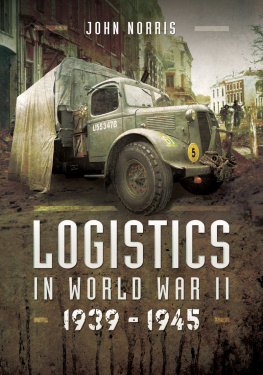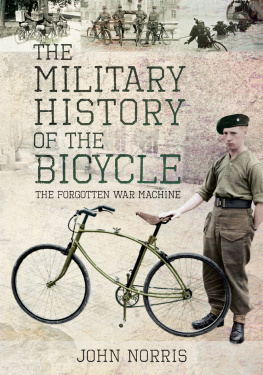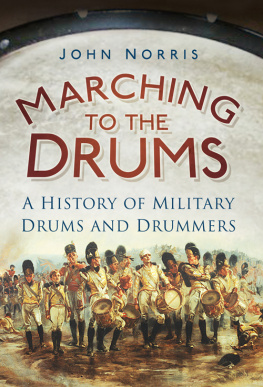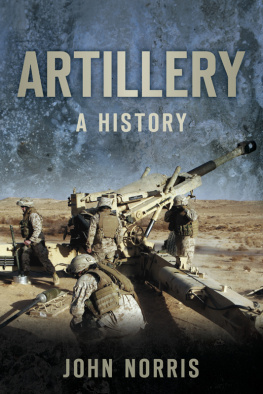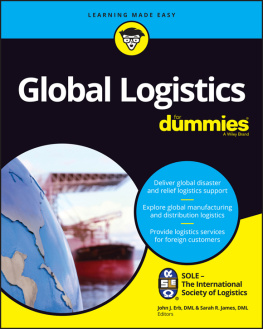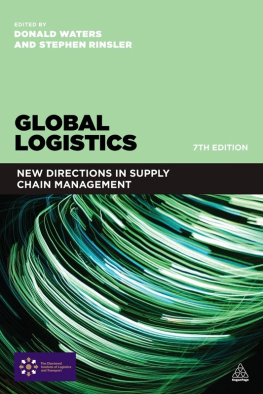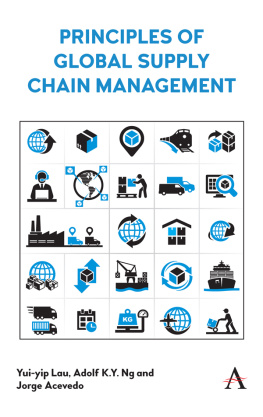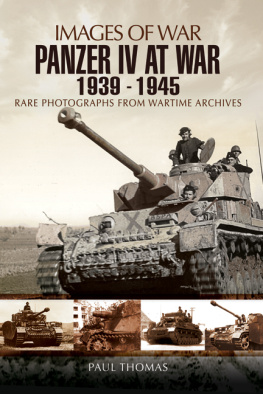Pagebreaks of the print version

Logistics in World War II
To a very dear friend. Thank you for the inspiration
Logistics in World War II
19391945
John Norris
First published in Great Britain in 2020 by
Pen & Sword Military
An imprint of
Pen & Sword Books Ltd
47 Church Street
Barnsley
South Yorkshire
S70 2AS
Copyright John Norris, 2020
ISBN 978 1 47385 912 8
eISBN 978 1 47385 914 2
Mobi ISBN 978 1 47385 913 5
The right of John Norris to be identified as Author of this work has been asserted by him in accordance with the Copyright, Designs and Patents Act 1988.
A CIP catalogue record for this book is available from the British Library.
All rights reserved. No part of this book may be reproduced or transmitted in any form or by any means, electronic or mechanical including photocopying, recording or by any information storage and retrieval system, without permission from the Publisher in writing.
Pen & Sword Books Limited incorporates the imprints of Atlas, Archaeology, Aviation, Discovery, Family History, Fiction, History, Maritime, Military, Military Classics, Politics, Select, Transport, True Crime, Air World, Frontline Publishing, Leo Cooper, Remember When, Seaforth Publishing, The Praetorian Press, Wharncliffe Local History, Wharncliffe Transport, Wharncliffe True Crime and White Owl.
For a complete list of Pen & Sword titles please contact
PEN & SWORD BOOKS LIMITED
47 Church Street, Barnsley, South Yorkshire, S70 2AS, England
E-mail:
Website: www.pen-and-sword.co.uk
Acknowledgements
I would like to extend my sincere thanks to all the museums where I have conducted research into the subject of logistics, namely the Royal Logistics Corps Museum at Deepcut in Surrey, the Imperial War Museum in London and the Tank Museum at Bovington in Dorset. I am also grateful to the Cobbaton Combat Collection in Devon and the Muckleburgh Collection in Norfolk. I am indebted to all the military historians who gave unstintingly of their time, answered many questions and explained things in detail. Without such assistance I could not have proceeded with this work.
Introduction
I t is one thing for a country to mobilise its army and deploy it for battle, but it requires a great deal of support to keep it continuously supplied to levels that allow it to fight to the best of its ability. During the Second World War armies required enormous amounts of ammunition, food, fuel and other supplies to keep them functioning. The war lasted for six years, during which time it drew in fifty-seven countries from five continents.
The fighting affected the largest nations in the world, and it also affected thousands of islands scattered around the worlds oceans, such as the islands of Japan and the Philippines, down to the peaceful Channel Islands of Jersey and Guernsey.
In every theatre of war, the armies had to be kept supplied and the wounded evacuated. This required vast resources from civilian labour in factories producing the kit to the non-combatant troops needed to move the supplies forward for distribution. Prisoners of war had to be dealt with by removing them from the fighting area. This involved transportation, either by railway or ships, often over thousands of miles, imposing a further strain on supply lines.
As the size of the armies grew and the fighting spread, commanders in the field realised that in order to conduct their campaigns they needed ever-increasing supplies to function at maximum capacity. Napoleon Bonaparte is famously misquoted as saying, An army marches on its stomach. What he actually said was, It is soup which makes the soldier. If an army is to be effective, and remain so, it has to be able to rely on good and plentiful supplies of food. However, feeding an army is only part of the problem. Pay, ammunition, providing replacement equipment, replacement troops and the evacuation of wounded combine to make up the lines of logistics. During the Second World War, supplies of fuel oil would prove to be the deciding factor in many cases. Without it, tanks could not move and aircraft could not fly.
Countries that became involved in the war were affected by logistics to a greater or lesser degree depending on their geographical position and commitment. Another factor to consider was their allegiance. The Allied countries benefitted from support even from the populations of occupied territories such as France, Belgium and Holland. In the case of Britain, it could count on countries within the British Empire, such as India, along with the Dominions including Canada, Australia and New Zealand, each of which would rally to Britains aid. The Axis powers of Germany, Italy and Japan would be joined by their own allies such as Hungary, Finland and Korea.
The third side to the conflict were those countries which had declared themselves neutral, such as Sweden, Switzerland and Portugal. These remained neutral throughout the war, and although not engaged in fighting they were inevitably affected by it, both socially and politically. Sweden and Switzerland profited financially by trading with both Allies and Axis forces and in that respect were treading a fine line, which, if crossed too far one way or the other, could see them becoming directly involved. Switzerland, for example, provided Germany with technological and industrial support for payment. By 1941 it had increased its exports of chemicals by 250 per cent from pre-war levels and exports of metals were increased by 500 per cent, all sold for premium prices. Then there were those countries, such as Turkey, Uruguay and Bolivia, which were neutral at the beginning of the war but later joined the Allies. Bolivia benefitted from trade, which in its case was to supply tin to the Allies. Its geographical location meant that, unlike Spain or Sweden, it was beyond the reach of enemy spies or attack by Axis forces.
Almost 250 years earlier, at the start of the eighteenth century, John Churchill, later to become the first Duke of Marlborough, proved himself to be the master of logistics when it came to planning his campaigns. Between 1701 and 1711, during the War of the Spanish Succession, Churchill planned for every possible contingency, applying precise attention to detail from the smallest of matters to the largest. He knew that feeding his army on campaign was of the utmost importance and realised the daily difficulties involved. For example, his army of 62,000 men at the Battle of Ramillies on 23 May 1706 consumed around 90 tons of bread each day which required 60 portable ovens and 200 wagons of fuel for the baking ovens. At one point Churchills supply line comprised 1,700 horse-drawn wagons, transporting 800 tons of stores. It was his meticulous planning which eventually led to him winning the war.
Two hundred years later, during the First World War, the Russian army was forced to stop fighting in 1917 due a collapse in its lines of logistics. With no food, clothing or ammunition reaching the troops, they became demoralised which affected their ability and willingness to fight. The situation was further compounded by political unrest in Moscow which developed into open revolution.
The situation for the British army could not have been more different. In 1914 Britain went to war with a standing army of some 250,000 men, 27,500 horses and 922 motor vehicles, including 80 trucks, 827 motor cars and 15 motorcycles. By 1918 the army had expanded to 5,363,000 troops, with 900,000 horses for transport and a fleet of motorised vehicles which had multiplied by 132 times to reach nearly 122,000 machines. This figure included 56,000 motor cars and 34,000 motorcycles, the remainder being trucks and armoured fighting vehicles (AFVs) in the form of tanks, armoured cars and the first self-propelled guns. To deal with this huge army, a series of supply depots for the distribution of war materiel was established in France, usually where railways and harbours could handle the bulk of shipments. Between January and October 1915 the supply depot at Calais issued to the British army 11,000 prismatic and magnetic compasses, 7,000 watches, 40,000 miles of electric cable, 40,000 electric torches, 3,600,000 yards of flannelette, 1,260,000 yards of rot-proof canvas, 25,000 tents, 1,600,000 waterproof sheets, 12,800 bicycles, 20,000 wheels, 6,000,000 anti-gas helmets, 4,000,000 pairs of horse and wheel shoes, 447,000 Lewis-gun magazines Between 1914 and 1918 the British army issued 137,224,141 pairs of socks to the troops and over 30,000 miles of flannelette cloth used for cleaning rifles and pistols. Administration services recorded everything and the offices had to be supplied with the equipment necessary to keep things moving. This included some 51,000 rubber stamps, so that a soldiers leave could be authorised or an attack confirmed. Rubber stamps were also involved in the issuing of rations, such as the monthly 40,000 tons of bread in 1914, or the 1,600 tons of meat per month which rose to 30,000 tons in 1918.

